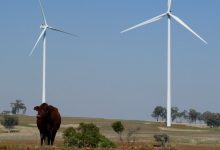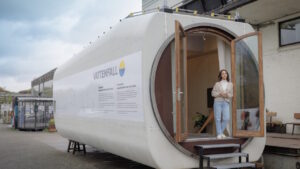The Australian Energy Market Operator has confirmed that wind and solar farms in eastern Australia will suffer major de-ratings of their output in the coming financial year as it released its final decision on so-called marginal loss factors.
However, the delayed release of the final assessment also includes reprieves for some solar farms – such as Parkes in NSW – which will not be de-rated anywhere the levels first thought, while the blow is softened marginally for most wind and solar farms since the initial draft assessment was released in March.
The final assessment – released late on Friday – confirms that the wind and solar farms near Broken Hill are the worst affected by the changes, along with other solar farms in south-west NSW, some wind and solar facilities in north-west Victoria and some solar farms in north Queensland.
Marginal loss factors dictate how much of generator’s output – be it wind, solar, gas, thermal or hydro – is credited by the market operator. A factor of 0.75, for instance, means the wind farm will get payment for only 75 per cent of its output. A rating of more 1.0, means it will be credited with more than its nominal output.
The issue over MLFs has been a controversial one in Australia, particularly in the last few years as many wind and solar farms – and other generators – suffered big de-ratings as a result of grid congestion, and the lack of local load to eat up the output.
The case of Broken Hill is a perfect illustration. Last year, the Silverton wind farm and the 52MW Broken Hill solar farm had high ratings – of 1.006 and 97.89 respectively. But these have been slashed as the output of Silverton increases, and most of the combined output has to be transported long distances on a constrained line.
The Silverton wind farm, still struggling with final connection issues, is now rated at 0.84, while Broken Hill solar is marked down to just 0.75. Still, this is not as bad as suggested in the draft March assessment, when Silverton was given a rating of 0.799, and Broken Hill solar a rating of 0.725.
On the other hand, areas in northern NSW, northern Victoria and in South Australia have had an increase in MLFs, due to changes in load or transmission flows. The Sapphire wind farm west of Glen Innes, for instance, is bumped up from 0.88 to 0.93 and the Lake Bonney wind farms in South Australia are also bumped up by more than 6 per cent.
The Nyngan solar farm (NSW), the Numurkah solar farm (Victoria) and the Taralga wind farm (NSW) also get small improvements from last year.

So, too, do the Bungala solar farms near Port Augusta in South Australia, and the neighbouring Lincoln Gap wind farm, along with the Hallett wind farms, the Dalrymple North battery on the Yorke Peninsula and the generation side of the Tesla big battery at Hornsdale.
But others to be marked down heavily (more than 10 per cent) are the Colleambally and Griffith solar farms in NSW, and the Karadoc, Wemen and Bannerton solar farms in Victoria. The Murra Warra, Challicum Hills and Kiata wind farms also suffered de-ratings of more than 6 per cent, although Kiata’s position is much better than advised in March.
To see an animated GIF of the changes to marginal loss factors in Australia, prepared by project management company Ekistica, click here.
The concern about MLFs has been heightened this year because AEMO was forced to make changes to its calculations – on an interim basis in April, and in its final assessment – after receiving more detailed information about several dozen wind and solar farms that are yet to be completed.
Some analysts wonder why Australia has MLFs in the first place, pointing to places like Texas where delivery of output is the responsibility of the grid owners, and it is up to them to make sure there is enough capacity.
There are also calls for changes to be made in the way the MLFs are calculated.
Mostly, it is a reflection of the poor planning in the grid, and particularly by the regulators and rule-makers who have been ill-prepared for the influx of more generators.
The lack of access to detail is also a problem. Wind and solar farm developers say they are often hamstrung because they have no visibility over what other generators may also be built in their part of the grid.
In its statement issued late on Friday, AEMO said the changes to the draft MLF assessment came after it “became aware that some information previously received by AEMO no longer reflected expected commissioning schedules” for several new generation projects.
“AEMO deferred finalisation of the 2019–20 MLFs to give proponents an opportunity to provide the most recent and accurate information for AEMO to use in the MLF calculations. Updates were requested for 46 projects, with 29 providing AEMO with updated generation profiles.
- Of the 46 new generator connections considered, 13 are registered and the remaining 33 are included in the 2019-20 MLF study due to their committed status, which means that are not yet complete, and there may be uncertainty as to when they will be. These represent approximately 4,500MW of new capacity that is being considered for the first time.
“AEMO has recalculated all MLFs based on this updated information from proponents,” it said. “This has resulted in changes to the MLFs from the draft factors published on April 1, 2019, including material changes for areas of Northern Queensland, South West New South Wales and North Western Victoria.
AEMO says it is committed to providing the market with “as much transparency as possible” about where new generation is expected to connect to the grid, seeking to answer one of the major concerns.
“AEMO is also considering more frequent MLF update publications which may assist in identifying changes and trends, as well as working with industry and the AEMC on possible options to reduce the impact of large year on year changes in MLFs.”
These may include the incorporation of “dynamic” MLFs, which would reflect grid constraints depending on time of day, and the output of other generation sources. Some say this is fairer than a blanket de-rating.
AEMO says its Integrated System Plan, which is being updated this year, is key to addressing the growing number of connections and constraint issues in the grid.
“In the longer term, Australia will need a stronger energy system to transport energy from where it is produced with fewer losses, to where it is consumed, minimising costs to consumers,” it said. AEMO’s Integrated System Plan is a blueprint for Australia to do just that. We need to start implementing this now.
“We look forward to working with the Australian Energy Market Commission (AEMC) and market participants to find improvements in how losses in the system are accounted for.”










